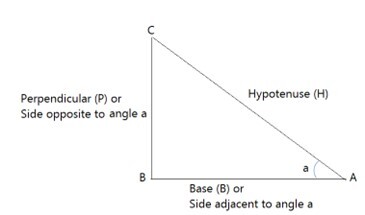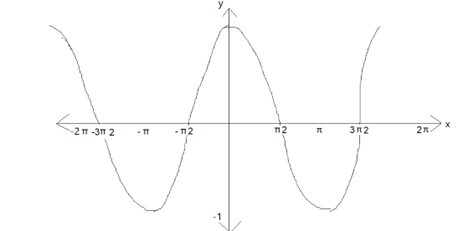
 Data Structure
Data Structure Networking
Networking RDBMS
RDBMS Operating System
Operating System Java
Java MS Excel
MS Excel iOS
iOS HTML
HTML CSS
CSS Android
Android Python
Python C Programming
C Programming C++
C++ C#
C# MongoDB
MongoDB MySQL
MySQL Javascript
Javascript PHP
PHP
- Selected Reading
- UPSC IAS Exams Notes
- Developer's Best Practices
- Questions and Answers
- Effective Resume Writing
- HR Interview Questions
- Computer Glossary
- Who is Who
Cos 0
Introduction
Cos 0 has a value of 1. When the angle of a right triangle equals zero degrees, a number known as the cosine of angle zero degrees reflects the ratio of the length of the neighbouring side to the length of the hypotenuse. The precise value of the cosine of angle 0 degrees is equal to 1, and the cos of angle 0 degrees is expressed as cos (0) in the sexagesimal notation.
Trigonometric Functions
The trigonometric functions in mathematics are real functions that connect the angle of a right-angled triangle to the ratios of its two side lengths. They are also known as circular functions.
What Is Trigonometric Functions
One of the six mathematical functions used to express the side ratios of right triangles, the trigonometric function includes the sine (sin), cosine (cos), tangent (tan), cotangent (cot), secant (sec), and cosecant (csc). The graphic shows these six trigonometric functions

Six basic trigonometric functions
There are six popular trigonometric functions for an angle. Sine (sin), cosine (cos), tangent (tan), cotangent (cot), secant (sec), and cosecant(csc) are their respective names and acronyms .
-
Sine Function The ratio of a right triangle's hypotenuse to its opposite side (perpendicular), known as the sine function of an angle in trigonometry.
Formula of Sin Function: Opposite Side/Hypotenuse= CB/CA
-
Cos Function The cosine, sometimes abbreviated "cos," is the ratio of the hypotenuse's length to the length of the side that is next to the angle.
Formula of Cos Function: Adjacent/Hypotenuse = AB/CA
-
Tan Function One of the primary six trigonometric functions, the tangent function is typically expressed as tan x. In a right-angled triangle, it is the ratio of the angle's opposing and adjacent sides that is taken into account.
Formula of Tan Function: Opposite/Adjacent = CB/BA
-
Secant, Cosecant and Cotangent Functions The three extra functions that result from sine, cosine, and tangent are secant, cosecant (csc), and cotangent. Cosecant (csc), Secant (sec), and Cotangent (cot) are the reciprocals of sine, cos, and tan, respectively. Each of these functions has the following formula
Sec a = 1/(cos a) = Hypotenuse/Adjacent = CA/AB
Cosec a = 1/(sin a) = Hypotenuse/Opposite = CA/CB
cot a = 1/(tan a) = Adjacent/Opposite = BA/CB
Cosine Function
The ratio between the neighbouring side and the hypotenuse is known as the cosine function (or cos function) in triangles. One of the three fundamental trigonometric functions, cosine is the complement of sine (co-sine)
Specifications of the Cosine Function
The cosine's properties depend on which quadrant the angle is in. A unique trigonometric function, the cosine function has a variety of characteristics. Following is a list of some of them
The fact that the cos x graph repeats itself after a period of two shows that the function has a period of two and is periodic.
Cos(x) = Cos(-x), making it an even function.
All real numbers fall inside the cosine function's domain, and its range is [-1,1].
The cosine's power series expansion is $\mathrm{cos x =?_{n=o}^?(-1)^n \frac{X^2n}{(2n)!}}$
Identity of the cosine function
There are various identities in trigonometry that involve the cosine function. The solutions to many arithmetic problems using these concepts are highly helpful. Following is a list of some of them
cos x = 1/ sec x
When x is between [-1, 1], the inverse of the cosine function is cos-1x = arccos x.
sin2x + cos2x = 1
cos (x-y) = cos x cos y - sin x sin y
cos (x-y) = cos x cos y + sin x sin y
cos2x = cos2 x -sin2 x=2cos2 x-1=1-2sin2 x
Cosine function integral: ?cosx=sinx+c, where C is the integration constant.
Cos 0
As you are well aware, trigonometric functions are angular functions that have to do with a triangle's angles. Trigonometric functions have been applied to the study of periodic events involving light and sound waves. These operations are also essential for understanding harmonic oscillations and fluctuations in the mean temperature.
Circular System with Cos = 0
In a circular system, "zero" does not exist. In a circular system, each and every number is regarded as positive.
Centesimal System for Cos 0
In total, there are 100 units in the census system. 1/100 and 1/101 are the first and second units, respectively. Up to 100, this pattern is maintained.
Cosine Function at other angles
If the ratio between the neighbouring side and hypotenuse is known, the cos inverse function may be used to calculate the angle of any right-angled triangle. The symbol for the cos inverse is cos-1?x or arccos. The angle may be calculated using the cos function for a right triangle with sides 1, 2, and 3.
Graph of Cosine Function
The trigonometric ratios can also be considered as functions of a variable which is the measure of an angle. This angle measure can either be given in degrees or radians. Here, we will use radians.

Solved Example
1) Find the values of Sin 45°, Cos 60° and Tan 60°.
answer: The trigonometric table provides us with
$$\mathrm{Sin45^\circ =\frac{1}{\sqrt{2}}}$$
$$\mathrm{Cos60^\circ =\frac{1}{2}}$$
$$\mathrm{Tan60^\circ =\sqrt{3}}$$
2) Calculate Sin 105 °.
Answer: Sin (60° + 45°) is a form of sin (105°), which is equivalent to sin (A + B).
We are aware that the formula for sin is sin (A + B). A = cosB + cos. A Ã sin B
Therefore, $\mathrm{sin 105^\circ=sin(60^\circ+45^\circ)=sin60^\circÃcos45^\circ+cos60^\circÃsin45^\circ}$
$$\mathrm{=\frac{?3}{2}Ã\frac{1}{?2}+\frac{1}{2}Ã\frac{1}{?2}}$$
$$\mathrm{=\frac{?3}{2} ?2+\frac{1}{2} ?2}$$
$$\mathrm{=\frac{(?3+1)}{2} ?2}$$
Conclusion
The trigonometric functions are the foundation of all trigonometry. The six trigonometric functions are sin, cos, tangent, cosec, sec, and cotangent. Trigonometric functions are used in geometry to determine the unknown side or angle of a right-angled triangle. For instance, the angle's hypotenuse and opposite are both equal. To quickly memorise the equations, utilise SOH CAH TOA.
FAQs
1. What does the symbol Cos 0 mean?
The cosine of 0° is 1. The fractional values of common angles such cos 0, 30, 45, 60, and 90° can all have positive roots.
2. What use does a trigonometric table serve?
You may discover the values of trigonometric standard angles for a variety of trigonometric ratios, including 0°, 30°, 45°, 60°, and 90°, by consulting the table of trigonometric ratios.
3. Why do we learn trigonometry?
The analysis and simplification of equations using different trigonometric functions like sine, cosine, tangent, etc. is the most productive and advanced usage of trigonometry.
4. What practical applications do trigonometric functions have?
Architecture and construction, communications, electrical engineering, flying, GPS, graphics, land surveying, music, and trajectories all utilise or contain trig functions.
5. What is inverse cosine?
It is the opposite of the cosine function. Occasionally shortened to "arccos" as well. When the length of two sides of the right triangle is known, it is used to calculate the unknown angle.

